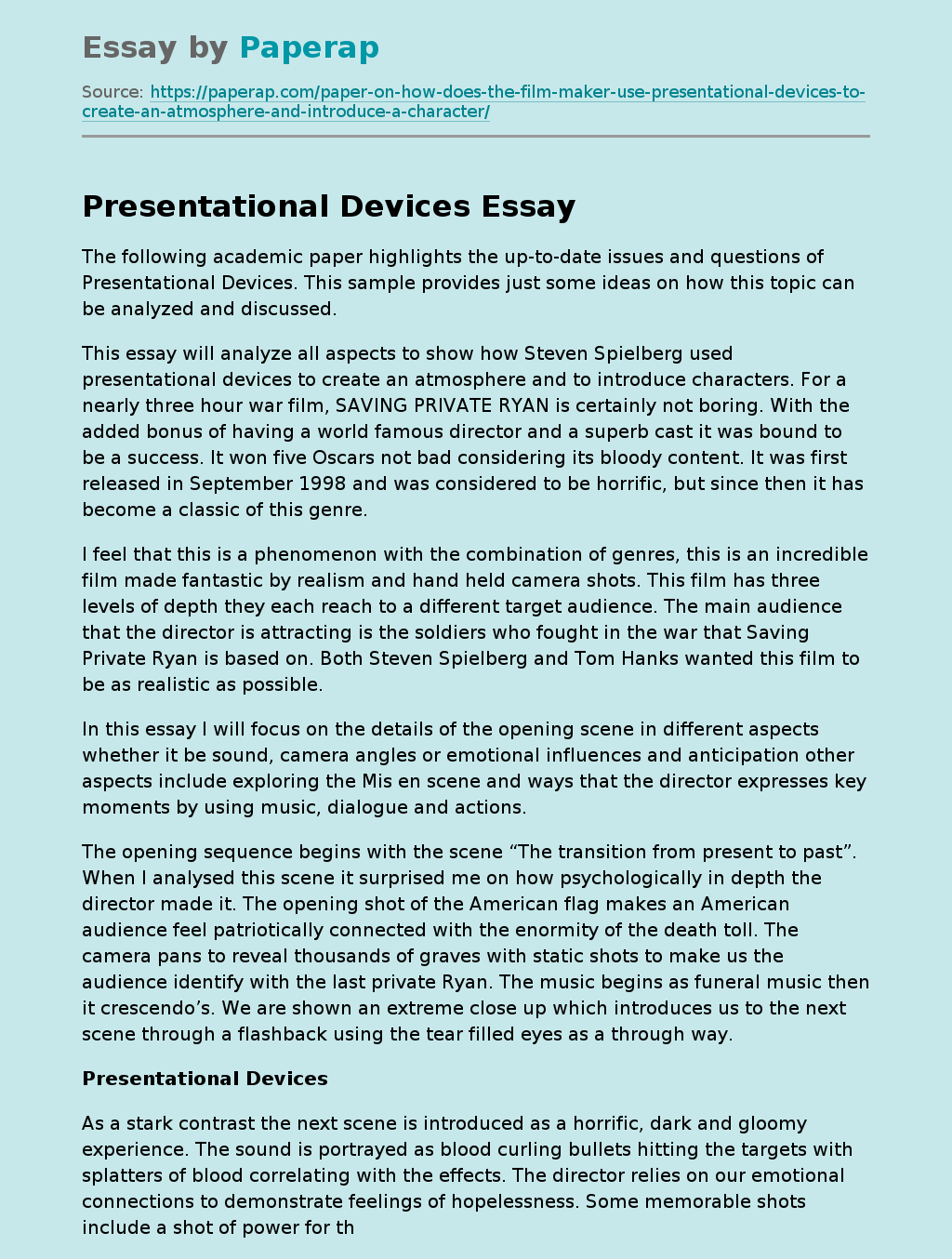Presentational Devices
The following academic paper highlights the up-to-date issues and questions of Presentational Devices. This sample provides just some ideas on how this topic can be analyzed and discussed.
This essay will analyze all aspects to show how Steven Spielberg used presentational devices to create an atmosphere and to introduce characters. For a nearly three hour war film, SAVING PRIVATE RYAN is certainly not boring. With the added bonus of having a world famous director and a superb cast it was bound to be a success.
It won five Oscars not bad considering its bloody content. It was first released in September 1998 and was considered to be horrific, but since then it has become a classic of this genre.
I feel that this is a phenomenon with the combination of genres, this is an incredible film made fantastic by realism and hand held camera shots. This film has three levels of depth they each reach to a different target audience. The main audience that the director is attracting is the soldiers who fought in the war that Saving Private Ryan is based on.
Both Steven Spielberg and Tom Hanks wanted this film to be as realistic as possible.
In this essay I will focus on the details of the opening scene in different aspects whether it be sound, camera angles or emotional influences and anticipation other aspects include exploring the Mis en scene and ways that the director expresses key moments by using music, dialogue and actions.
The opening sequence begins with the scene “The transition from present to past”.
When I analysed this scene it surprised me on how psychologically in depth the director made it. The opening shot of the American flag makes an American audience feel patriotically connected with the enormity of the death toll. The camera pans to reveal thousands of graves with static shots to make us the audience identify with the last private Ryan. The music begins as funeral music then it crescendo’s. We are shown an extreme close up which introduces us to the next scene through a flashback using the tear filled eyes as a through way.
Presentational Devices
As a stark contrast the next scene is introduced as a horrific, dark and gloomy experience. The sound is portrayed as blood curling bullets hitting the targets with splatters of blood correlating with the effects. The director relies on our emotional connections to demonstrate feelings of hopelessness. Some memorable shots include a shot of power for the enemies where we see the devastation from the German’s point of view.
Muffled dialogue expresses a realistic view of the war as well as, when they land it is quiet and all we hear is the rattling of bullets colliding with helmets. The cameras are hand held and show various perspectives in order to portray the overall scene of carnage.
This scene makes sure that we the audience are emotionally connected. The audience feel as if we are sharing this experience. Consequently we are aware of the psychological aspects that Captain Miller is feeling during coming face to face with the carnage of this scene.
The focus of this scene is to make us identify with the horrors around him by using slow motion and jerky shots. This is a point of view over shoulder shot. It expresses how the men trust and look up to him for leadership. Despite there being no music we still correlate with Captain Miller. The director shows us that he is still human by involving the audience it is almost an out of body experience.
As the final part of my analysis this scene “the end of battle” is hard hitting both emotionally and physically. The director uses the same elements as in the first scene to prepare us the audience for the devastating panning shot. By using clever methods the director twists what would normally be a pleasant saying to a truly devastating devise. Steven Spielberg uses a through way via captain Millers eyes to introduce the wide angled panning shot.
The use of the statement “that’s quiet a view” almost prepares us for a pleasant landscape such as a beautiful sun setting. The true fact of this statement is to make us feel as if were aware of what is going to happen so we are shocked about the truth. This is supported with the emotional portrayal of captain Millers eyes.
When the camera angle pans we witness the bloody sea lapping at the horrific imagery of the still and lifeless bodies now at peace after the mass slaughter of the bloody battle. This scene also shows how struggling soldiers defended themselves by using dead comrades as human shields, this is a very poignant scene supported with the splatters of blood on the camera.
The purpose of this essay was to analyse how the director uses presentational devises to create an atmosphere and the introduction of a character. In my opinion Steven Spielberg made this film as realistic as is conceivably possible. This was aided by the factor that he used real amputees for a more realistic effect.
The presentational devises were extremely effective in all aspects whether it be dialogue, music or actions. In my opinion this is an extremely harrowing film with elements of treachery, morals and sanctity. I think that this film has expressed what veterans had to face. Steven Spielberg has tactfully recreated the war with reality, honour and pride.
Presentational Devices. (2019, Dec 07). Retrieved from https://paperap.com/paper-on-how-does-the-film-maker-use-presentational-devices-to-create-an-atmosphere-and-introduce-a-character/

